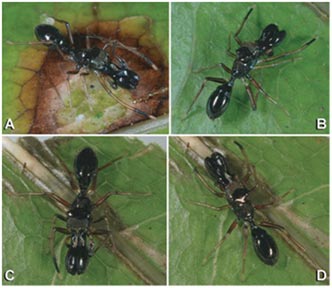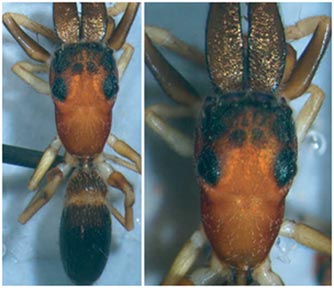Not quite an ant…
The discovery of the antlike jumping spiders of Sri
Lanka:
|

Myrmarachnemorningsidesp. nov. (A–D) male in life. |
Sri Lanka is one of the smallest, but biologically one of the most
diverse countries in Asia. So it is recognized as a biodiversity hotspot
of global and national importance. The country’s varied climate and
diverse geographical conditions have given rise to this rich species
diversity, believed to be the highest in Asia in terms of unit land
area. The diversity of ecosystems in the country has resulted in a host
of habitats, which contain high genetic diversity.
Spiders (order Araneae) are arthropods that have eight legs and
chelicerae with fangs that inject venom. They are highly diverse group
of invertebrates and occupy various habitats. Professor Suresh P.
Benjamin, Associate Research Professor of the Department of Ecology and
Environmental Biology, National Institute of Fundamental Studies, Kandy,
has been able to describe/redescribe all nominal species of
ant-mimicking jumping spiders of the genus Myrmarachne in Sri Lanka,
based on type and newly collected material. Also he has been able to
skillfully identify and describe three new ant-mimicking jumping
spiders’ species. His discoveries were published in the May issue of
international peer reviewed Journal of Natural History.
Jumping spider
The ant-mimicking genus Myrmarachne is one of the most species rich
genera of Salticidae (jumping spider). The Myrmarachne is a genus of
jumping spiders which imitate the ant by waving their front legs in the
air to simulate the antennae. Some species also look strikingly like
ants.
Apart from a few studies, generally very little is known of the
behaviour and life history of the Myrmarachne. Although they generally
tend to be found close to ants, they are known to actively avoid contact
with them.
However, after the work of Professor P. Benjamin, a total of 12 valid
species are now well known from the island and six of them are endemic
to Sri Lanka Myrmarachneaurantiaca, Myrmarachnedishani and
Myrmarachnemorningside are the newly described ant-like jumping spiders
species identified by Professor Benjamin. All species are well
illustrated facilitating easy identification in the field.
Myrmarachneaurantiaca, one of the three new species was discovered
from the Ethagala range of Kurunegala District, North Western Province.
M.aurantiaca is separated from other Sri Lankan Myrmarachne species
by the body size, dorsally flat surface of the male chelicerae and
reddish orange-coloured carapace
|

Myrmarachneaurantiaca |
Myrmarachnedishani, the second new species was discovered from
Eastern Sinharaja forest. The species has been named for his wife
Dishani P. Benjamin. It can be clearly identified from all other Sri
Lankan species of the genus, except for M. imbellis, by the presence of
a cylindrical opisthosoma, which lacks any visible, constrict.
Morningside
The Holotypeof Myrmarachne morningside, the third new species was
discovered from Eastern Sinharaja forest, Morningside section. M.
morningside is very similar in outward appearance to M. spissa.
Separated from it by the disk-shapedtegulum and shiny appearance, mostly
of the dorsal parts of the prosoma. It is endemic to Sri Lanka. This
spices was found to be present in Gilimale Forest as well.
Apart from these three newly discovered species, Professor Benjamin
has also been able to re-describe several more Myrmarachne species,
which were previously known, by using newly collected specimens. Those
species are Myrmarachneimbellis, Myrmarachnepaludosa ,Myrmarachnepaludos,Myrmarachneprava.,
Myrmarachneplataleoides and Myrmarachnespissa. Among those,
Myrmarachnepaludosa is found only in Sri Lanka and is probably endemic,
as it occurs only in primary forest of the wet zone and is absent in the
surrounding dry forest and coastal regions.
The antlike jumping spiders are a less known bio diversity feature in
Sri Lanka. This study opens yet another window to Sri Lanka’s rich but
threatened bio diversity. The study was funded by the Institute of
Fundamental Studies with additional funding coming from a fellowship
from the Alexander von Humboldt Foundation.
Professor Suresh P. Benjamin was interviewed in
this article compiled by Pradeep Piyathilaka,Communication & Media
Officer, Science Education & Dissemination Unit, National Institute of
Fundamental Studies, Kandy |

